|
Size: 10148
Comment:
|
Size: 15167
Comment:
|
| Deletions are marked like this. | Additions are marked like this. |
| Line 2: | Line 2: |
| This page describes the various coordinate systems used in Brainstorm, and explains how to convert beetween referentials. |
|
| Line 5: | Line 7: |
| Brainstorm uses the CTF coordinate sytem. All the surfaces, sensors and additional points are converted into this system when they are imported in Brainstorm. | Brainstorm uses the CTF head coordinate system. All the surfaces, sensors and additional points are converted into this system when they are imported in Brainstorm. |
| Line 10: | Line 12: |
| * __Origin__: Midway on the line joining LPA and RPA * __Axis X__: From the origin towards the Nasion (exactly through) * __Axis Y__: From the origin towards LPA in the plane defined by (NAS,LPA,RPA), and orthogonal to X axis * __Axiz Z__: From the origin towards the top of the head |
* __Origin__: Midway on the line joining LPA and RPA. * __Axis X__: From the origin towards the Nasion (exactly through). * __Axis Y__: From the origin towards LPA in the plane defined by (NAS,LPA,RPA), and orthogonal. to X axis. * __Axiz Z__: From the origin towards the top of the head. |
| Line 20: | Line 22: |
| {{attachment:NAS.gif}} | {{attachment:NAS.gif||width="599",height="213"}} |
| Line 23: | Line 25: |
| <<HTML(<div style="float: left; clear: right; margin: 0px 20px 0px 20px;">)>> {{attachment:preauricular.gif||width="148",height="235"}} <<HTML(</div>)>> |
|
| Line 25: | Line 31: |
| Our proposition is to use instead the junction between the tragus and the helix, marked with a red dot in the following figure. It can be located much more precisely both anatomically and on the MRI slices. | Our proposition is to use instead the junction between the tragus and the helix, marked with a '''red dot''' in this figure. It can be located much more precisely both anatomically and on the MRI slices. |
| Line 27: | Line 33: |
| {{attachment:preauricular.gif}} | You can choose to use this definition of the "preauricular point" or not. '''The most important is to use the same convention for all the steps: digitization of head points''' (eg. Polhemus) '''and analysis with Brainstorm'''. <<HTML(<div style="clear: both;"></div>)>> |
| Line 31: | Line 39: |
| {{attachment:LPA.gif}} You can choose to use this definition of the "preauricular point" or not. The most important is to use the same convention for all the steps: digitization of head points with a magnetic system (Isotrak Polhemus, ...), and analysis with Brainstorm.<<BR>><<BR>> |
{{attachment:LPA.gif||width="599",height="213"}} |
| Line 36: | Line 42: |
| Using a CTF system, you would probably prefer to use the head localization coils to indicate those NAS/LPA/RPA points, instead of those "anatomically correct" points. The coordinate system in the CTF files is based on the position of the three coils you stick on the head of the subject. Typically, the nose coil is slightly above the nasion, and the ear coils about one centimeter more frontal than the points that were previously described. | Using a CTF system, you would probably prefer to use the head localization coils to indicate these NAS/LPA/RPA points, instead of these "anatomically correct" points. The coordinate system in the CTF files is based on the position of the three coils you stick on the head of the subject. Typically, the nose coil is slightly above the nasion, and the ear coils about one centimeter more frontal than the points that were previously described. |
| Line 42: | Line 48: |
| __'''IMPORTANT'''__: Those comments __do not apply__ if you use the [[Tutorials/TutDigitize|Brainstorm Digitize]] program to drive the Polhemus device. In this case, you are asked to digitize two sets of NAS/LPA/RPA points: the coils and the real anatomical points. Just make a copy of the .pos file saved by Digitize in the .ds folder, then set the real anatomical points in the MRI. Brainstorm is going to handle automatically the transformation between the CTF coils coordinate system and the real subject coordinate system. The result is usually much more accurate and does not require to take pictures of the subjects. | __'''IMPORTANT'''__: These comments __do not apply__ if you use the [[Tutorials/TutDigitize|Brainstorm Digitize]] program to drive the Polhemus device. In this case, you are asked to digitize two sets of NAS/LPA/RPA points: the coils and the real anatomical points. Just make a copy of the [[http://neuroimage.usc.edu/brainstorm/CoordinateSystems#Brainstorm_.pos_files|.pos file]] saved by Digitize in the .ds folder, then set the real anatomical points in the MRI. Brainstorm is going to automatically handle the transformation between the CTF coils coordinate system and the real subject coordinate system. The result is usually much more accurate and does not require to take pictures of the subjects. |
| Line 45: | Line 51: |
| The fiducial points (Nasion, LPA, RPA) used in your recordings might not be the same as the ones used in the anatomy templates in Brainstorm (Colin27, ICBM, FSAverage). By default, the LPA/RPA points are defined at the junction between the tragus and the helix, as represented with the red dot. | The fiducial points (Nasion, LPA, RPA) used in your recordings might not be the same as the ones used in the anatomy templates in Brainstorm (Colin27, ICBM152, FSAverage). By default, the LPA/RPA points are defined at the junction between the tragus and the helix, as represented with the red dot. |
| Line 47: | Line 53: |
| If you want to use an anatomy template but you are using a different convention when digitizing the position of those points, you have to modify the default positions of the template with the MRI Viewer. | If you want to use an anatomy template but you are using a different convention when digitizing the position of these points, you have to modify the default positions of the template with the MRI Viewer. |
| Line 53: | Line 59: |
== MNI coordinates == Two types of normalized coordinates are widely used in the literature: the atlas defined by [[http://en.wikipedia.org/wiki/Jean_Talairach|Jean Talairach]], and the [[http://www.bic.mni.mcgill.ca/~louis/stx_history.html|MNI stereotaxic coordinates]]. You can read about the differences between those two systems on that page: http://imaging.mrc-cbu.cam.ac.uk/imaging/MniTalairach Two of the templates distributed with Brainstorm ([[http://neuroimage.usc.edu/brainstorm/Tutorials/TutFirstSteps#Change_the_default_anatomy|Colin27 and ICBM152]]) are registered in the MNI stereotaxic space, therefore the "MNI coordinates" can be derived easily from the MRI voxel coordinates. For those two brains, you can read the normalized MNI coordinates directly in the interface ("MRI Viewer" or "Get coordinates" menu). The values should be almost identical to what you get when opening those volumes with the "Display" program from the [[http://en.wikibooks.org/wiki/MINC|MINC tools]]. To be able to get "MNI coordinates" for individual brains, an extra step of normalization is required.<<BR>>The method we use in Brainstorm is based on an affine co-registration with the MNI ICBM152 template from the SPM software. This function directly uses code from SPM12 (spm_maff8 ©J Ashburner), described in the following article: Ashburner J, Friston KJ, [[http://www.ncbi.nlm.nih.gov/pubmed/15955494|Unified segmentation]], NeuroImage 2005 To compute the linear transformation matrix between the individual MRI and the ICBM152 template: * In the MRI Viewer, click on the "Click here to compute MNI transformation" * Right-click on the MRI > Compute MNI transformation. == Talairach coordinates == If we cannot compute the MNI transformation as presented in the previous section, we use an approximation to the Talaraich coordinate system. It relies on two points, the posterior and anterior commissure, and the midsagittal plane. The third point needed here, the interhemispheric point, is used to define this plane. You can read about the differences between those two systems on that page: === Anterior commissure (AC) === Description of the anterior commissure at [[http://en.wikipedia.org/wiki/Anterior_commissure|this Wikipedia page]]. Technique to localize it: * Use the axial orientation. * Start from a slice just below the corpus callosum and move around it (slightly up or down) * You are looking for a small fiber tract that connects the two hemispheres * You should find two spots corresponding to this description. The more frontal one is the anterior commissure, the other one is the posterior commissure * Once you have localized it: if it is visible on more than one slice, use the upper one (the one closest to the top of the head). {{attachment:AC.gif}} === Posterior commissure (PC) === Description of the posterior commissure at [[http://en.wikipedia.org/wiki/Posterior_commissure|this Wikipedia page]]. Technique to localize it: * Use the axial orientation * It is a fiber tract similar to the anterior commissure, but a few centimeters more posterior. * If it is visible on more than one slice, pick the lowest one. {{attachment:PC.gif}} === Interhemispheric point (IH) === Pick any point in the interhemispheric space, somewhere in the top of the head. Do not use a point too close from the commissures. {{attachment:IH.gif}} <<BR>><<BR>> == Neuromag coordinates == This coordinates system is not used in Brainstorm, and described here only FYI. All the information contained in Neuromag .FIF files are in this CS, and converted to Brainstorm SCS at importation. It is defined in the following way: * __Based on__: Nasion, left pre-auricular point (LPA), and right pre-auricular point (RPA). * __Origin__: Intersection of the line L through LPA and RPA and a plane orthogonal to L and passing through the nasion. * __Axis X__: From the origin towards the RPA point (exactly through) * __Axis Y__: From the origin towards the nasion (exactly through) * __Axiz Z__: From the origin towards the top of the head |
|
| Line 115: | Line 66: |
| * Coordinates of the first voxel at the bottom-left-posterior of the MRI volume: (1,1,1) | * The first voxel at the bottom-left-posterior of the MRI volume is voxel (1,1,1). The coordinates of the center of this voxel in millimeters is (voxelsize_x, voxelsize_y, voxelsize_z). == World coordinates == Coordinates system used in the original MRI file, that was loaded as the reference MRI for a subject. It is defined by a 4x4 matrix saved directly in the MRI file. From NIfTI .nii files, it uses the matrix''' sform''' if available, or otherwise the matrix '''qform''' (see the [[https://nifti.nimh.nih.gov/nifti-1/documentation/nifti1fields/nifti1fields_pages/qsform.html|NIfTI documentation]]). From FreeSurfer .mgh/.mgz files, it uses the '''vox2ras''' matrix (see the [[https://surfer.nmr.mgh.harvard.edu/fswiki/CoordinateSystems|FreeSurfer documentation]]). In practical terms, it corresponds to the coordinates you see in the title bar when loading your volume in [[http://people.cas.sc.edu/rorden/mricron/index.html|MRIcron]]. The coordinates you see in the text boxes correspond in Brainstorm vocabulary to "voxel coordinates". For subject data, it corresponds most of the time to '''scanner coordinates'''. For atlases, it may correspond to normalized coordinates (e.g. MNI coordinates). == MNI coordinates == In order to compare the anatomy of multiple human brains or compute group statistics, it is necessary to define a common reference system. Two types of normalized systems have been widely used in the literature in the past: the atlas defined by [[http://en.wikipedia.org/wiki/Jean_Talairach|Jean Talairach]], and the [[http://www.bic.mni.mcgill.ca/~louis/stx_history.html|MNI stereotaxic coordinates]]. You can read about the differences between these two systems on that page: http://imaging.mrc-cbu.cam.ac.uk/imaging/MniTalairach While the Talaraich system has been progressively abandonned, the "MNI space" has been increasingly used, thanks to the development of automatic normalization methods in open-source neuroimaging software. Successive updates to the reference brain and software versions led to the coexistence of multiple "MNI spaces". For an exhaustive list, please refer to these two websites: * '''BIDS''': https://bids-specification.readthedocs.io/en/latest/99-appendices/08-coordinate-systems.html#standard-template-identifiers * '''Lead-DBS''': https://www.lead-dbs.org/about-the-mni-spaces/ In Brainstorm, '''MNI coordinates''' refer to the normalized space defined in '''SPM12''', also referred to as '''IXI549''' space. There are two solutions available for obtaining MNI coordinates in the Brainstorm MRI viewer: a linear and a non-linear approach, both are computed using SPM12. Wheter you compute the MNI normalization from the MRI viewer or the database explorer, you get this message: {{attachment:mni_norm.gif}} === MNI: Linear === * A [4x4] affine transformation is computed and saved in the [[https://neuroimage.usc.edu/brainstorm/Tutorials/ExploreAnatomy#On_the_hard_drive:_MRI|MRI NCS structure]]: * '''R''': [3x3] rotation matrix from the MRI coordinates to the MNI coordinates. * '''T''': [3x1] translation matrix from the MRI coordinates MNI coordinates. * The function [[https://github.com/brainstorm-tools/brainstorm3/blob/master/toolbox/anatomy/bst_normalize_mni.m|mri_normalize_maff.m]] uses code from SPM12 (spm_maff8 ©J Ashburner), described in the following article: Ashburner J, Friston KJ, [[http://www.ncbi.nlm.nih.gov/pubmed/15955494|Unified segmentation]], NeuroImage 2005 * This transformation is fast to compute, fast to apply to 3D coordinates, and very light in terms of storage. It is appropriate for computing a deformation of the bounding box of the brain and adapted for quickly aligning brains in the same space. However, it cannot represent the differences in the cortical folding of the individual brains. === MNI: Non-linear === * Description * Significant increase in file size: ... Templates: As the reference anatomy, we use the [[http://nist.mni.mcgill.ca/?p=904|ICBM125 2009c Nonlinear Asymmetric]], as described in the tutorial [[https://neuroimage.usc.edu/brainstorm/Tutorials/DefaultAnatomy|Using the anatomy templates]]. MNI parcellations: ... == Talairach coordinates == ''> This is not much used ''in Brainstorm anymore. '' '' ''If we cannot compute the MNI normalization as presented in the previous section, we use an approximation to the Talaraich coordinate system. It relies on two points, the posterior and anterior commissure, and the midsagittal plane. The third point needed here, the interhemispheric point, is used to define this plane. You can read about the differences between these two systems on that page: '' === Anterior commissure (AC) === ''Description of the anterior commissure at [[http://en.wikipedia.org/wiki/Anterior_commissure|this Wikipedia page]]. '' ''Technique to localize it: '' * ''Use the axial orientation. '' * ''Start from a slice just below the corpus callosum and move around it (slightly up or down) '' * ''You are looking for a small fiber tract that connects the two hemispheres '' * ''You should find two spots corresponding to this description. The more frontal one is the anterior commissure, the other one is the posterior commissure '' * ''Once you have localized it: if it is visible on more than one slice, use the upper one (the one closest to the top of the head). '' '' {{attachment:AC.gif||width="601",height="214"}} '' === Posterior commissure (PC) === ''Description of the posterior commissure at [[http://en.wikipedia.org/wiki/Posterior_commissure|this Wikipedia page]]. '' ''Technique to localize it: '' * ''Use the axial orientation '' * ''It is a fiber tract similar to the anterior commissure, but a few centimeters more posterior. '' * ''If it is visible on more than one slice, pick the lowest one. '' '' {{attachment:PC.gif||width="600",height="213"}} '' === Interhemispheric point (IH) === ''Pick any point in the interhemispheric space, somewhere in the top of the head. Do not use a point too close from the commissures. '' '' {{attachment:IH.gif||width="599",height="213"}} <<BR>><<BR>> '' == Neuromag coordinates == ''This coordinates system is not used in Brainstorm, and described here only FYI. All the information contained in Neuromag .FIF files are in this CS, and converted to Brainstorm SCS at importation. '' ''It is defined in the following way: '' * ''__Based on__: Nasion, left pre-auricular point (LPA), and right pre-auricular point (RPA). '' * ''__Origin__: Intersection of the line L through LPA and RPA and a plane orthogonal to L and passing through the nasion. '' * ''__Axis X__: From the origin towards the RPA point (exactly through) '' * ''__Axis Y__: From the origin towards the nasion (exactly through) '' * ''__Axiz Z__: From the origin towards the top of the head '' |
| Line 118: | Line 152: |
| The conversions between coordinate systems is handled with one single function cs_convert: | ''The conversions between coordinate systems is handled with one single function cs_convert: '' |
| Line 120: | Line 154: |
| * sMri: MRI structure from the database: right-click on the MRI file > File > Export to Matlab > sMri * src/dest: Source and destination coordinates systems: {'voxel', 'mri', 'scs', 'mni'} * P: List of points [Npoints x 3] |
* ''sMri: MRI structure from the database: right-click on the MRI file > File > Export to Matlab > sMri '' * ''src/dest: Source and destination coordinates systems: {'voxel', 'mri', 'scs', 'mni', 'world'} '' * ''P: List of points [Npoints x 3] '' * ''All the the coordinates have to be in '''meters''' (not millimeters). '' |
| Line 125: | Line 160: |
| Pdest = cs_convert(sMri, 'src', 'dest', Psrc); | |
| Line 127: | Line 161: |
| Examples: | ''Examples: '' |
| Line 130: | Line 164: |
| P_mri = cs_convert(sMri, 'voxel', 'mri', P_voxel); % Voxel => MRI coordinates P_mni = cs_convert(sMri, 'scs', 'mni', P_scs); % SCS => MNI coordinates |
|
| Line 133: | Line 165: |
| == Additional discussion on the forum == * [[http://neuroimage.usc.edu/forums/showthread.php?1429-Bad-MEG-MRI-coregistration-with-Polhemus|http://neuroimage.usc.edu/forums/showthread.php?1429-Bad-MEG-MRI-coregistration]] |
== Brainstorm .pos files == ''The .pos files generated with the [[Tutorials/TutDigitize|Brainstorm Digitizer]] contain both the positions of the '''anatomical landmarks''' (nasion, left ear, right ear) and the position of the '''head localization coils''' (HPI). '' |
| Line 136: | Line 168: |
| * http://neuroimage.usc.edu/forums/showthread.php?1389-Co-registration | ''Having the two sets of points allows us to convert automatically from the native CTF coordinates (based on the coils) to the recommended landmarks in Brainstorm (based on the anatomical landmarks). When a '''Brainstorm .pos file''' is present in the CTF '''.ds folder''', it is loaded automatically and used to convert the positions of the EEG and MEG sensors to the anatomical reference. This is done automatically without any message or user confirmation. In this case, you should mark the '''anatomical landmarks''' (real nasion and tragus/helix junctions) in the MRI Viewer when importing the anatomy. This is what is described in the [[Tutorials/ImportAnatomy|introduction tutorials]]. '' |
| Line 138: | Line 170: |
| * http://neuroimage.usc.edu/forums/showthread.php?1958-SEEG-electrodes-and-subject-s-anatomy-are-not-alligned | ''Otherwise, if you are importing CTF recordings '''without a Brainstorm .pos file''' in the .ds folders, or if you are importing the .pos files after linking the recordings to the database, you should typically select the positions of the '''CTF HPI coils''' in the MRI viewer. '' |
| Line 140: | Line 172: |
| <<EmbedContent(http://neuroimage.usc.edu/bst/get_feedback.php?Tutorials/CoordinateSystems)>> | ''The syntax of these .pos files is the following, one line per digitized point: '' {{{ }}} ''In the .pos files, the anatomical landmarks are labelled '''Nasion/LPA/RPA''', and the CTF HPI coils are labelled '''HPI-N/HPI-L/HPI-R''' (for nasion coil, left coil, right coil). Note that in the CTF software, the HPI coils are labelled NAS/LPA/RPA, which can lead to some confusion. '' ''We usually take multiple measures of each reference point and average them when we load the file. This helps improving the accuracy of the registration. '' {{{ }}} == Additional documentation == * ''Tutorial: [[http://neuroimage.usc.edu/brainstorm/Tutorials/ChannelFile|Channel file / MRI registration]] '' * ''Forum: [[http://neuroimage.usc.edu/forums/showthread.php?1429|Bad MEG-MRI registration]] '' * ''Forum: [[http://neuroimage.usc.edu/forums/showthread.php?1389|Coregistration validation]] '' * ''Forum: Import the position of SEEG/ECOG contacts: [[http://neuroimage.usc.edu/forums/showthread.php?2206|Post #2206]], [[http://neuroimage.usc.edu/forums/showthread.php?1958|Post #1958]], [[http://neuroimage.usc.edu/forums/showthread.php?2357|Post #2357]] '' ''<<EmbedContent(http://neuroimage.usc.edu/bst/get_feedback.php?Tutorials/CoordinateSystems)>> '' |
Coordinate systems
This page describes the various coordinate systems used in Brainstorm, and explains how to convert beetween referentials.
Contents
Subject Coordinate System (SCS / CTF)
Brainstorm uses the CTF head coordinate system. All the surfaces, sensors and additional points are converted into this system when they are imported in Brainstorm.
It is defined in the following way:
Based on: Nasion, left pre-auricular point (LPA), and right pre-auricular point (RPA).
Origin: Midway on the line joining LPA and RPA.
Axis X: From the origin towards the Nasion (exactly through).
Axis Y: From the origin towards LPA in the plane defined by (NAS,LPA,RPA), and orthogonal. to X axis.
Axiz Z: From the origin towards the top of the head.
Nasion (NAS)
The nasion is the intersection of the frontal and two nasal bones of the human skull. Its manifestation on the visible surface of the face is a distinctly depressed area directly between the eyes, just superior to the bridge of the nose (source: Wikipedia).
Use the coronal orientation to define it.
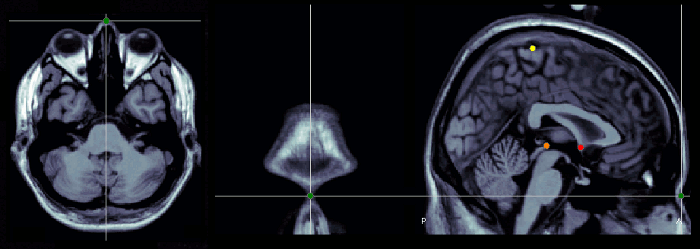
Pre-auricular points (LPA, RPA)
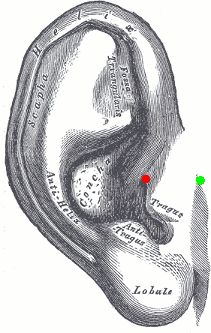
The proper definition of the preauricular point is: "a point of the posterior root of the zygomatic arch lying immediately in front of the upper end of the tragus". This is illustrated with the green point below. The problem with this definition is that it can be really difficult to localize precisely on the MRI. It can lead to severe misregistration between MRI and MEG/EEG. More information on the anatomical location of this point on the FieldTrip website.
Our proposition is to use instead the junction between the tragus and the helix, marked with a red dot in this figure. It can be located much more precisely both anatomically and on the MRI slices.
You can choose to use this definition of the "preauricular point" or not. The most important is to use the same convention for all the steps: digitization of head points (eg. Polhemus) and analysis with Brainstorm.
Use the sagittal orientation to define it.
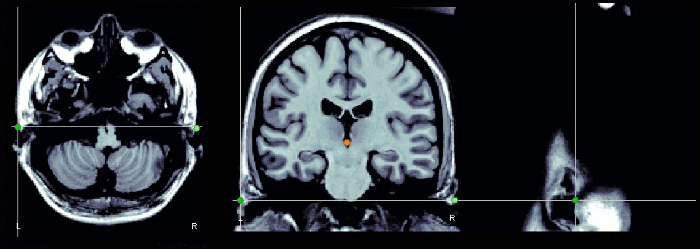
Notes for CTF users
Using a CTF system, you would probably prefer to use the head localization coils to indicate these NAS/LPA/RPA points, instead of these "anatomically correct" points. The coordinate system in the CTF files is based on the position of the three coils you stick on the head of the subject. Typically, the nose coil is slightly above the nasion, and the ear coils about one centimeter more frontal than the points that were previously described.
A good practice is to take pictures of the subject with the coils on, right before bringing him/her in the MEG, and digitize the position of the center of the coils as the nasion/LPA/RPA. Then, when importing the MRI in Brainstorm, try marking as accurately as possible the position of the coils in the MRI. You cannot be very precise at this point, but the errors here are fixed later with the automatic registration.
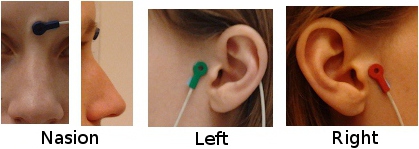
IMPORTANT: These comments do not apply if you use the Brainstorm Digitize program to drive the Polhemus device. In this case, you are asked to digitize two sets of NAS/LPA/RPA points: the coils and the real anatomical points. Just make a copy of the .pos file saved by Digitize in the .ds folder, then set the real anatomical points in the MRI. Brainstorm is going to automatically handle the transformation between the CTF coils coordinate system and the real subject coordinate system. The result is usually much more accurate and does not require to take pictures of the subjects.
Using a default anatomy
The fiducial points (Nasion, LPA, RPA) used in your recordings might not be the same as the ones used in the anatomy templates in Brainstorm (Colin27, ICBM152, FSAverage). By default, the LPA/RPA points are defined at the junction between the tragus and the helix, as represented with the red dot.
If you want to use an anatomy template but you are using a different convention when digitizing the position of these points, you have to modify the default positions of the template with the MRI Viewer.
- Go to the anatomy view
In (default anatomy), right-click on the MRI > Edit MRI
- Modify the position of the fiducial points to match your own convention
- Click on [Save], it will update the surfaces to match the new coordinate system
MRI coordinates
Coordinates system used to index voxels in the space of the MRI volume, in millimeters:
Axis X: left>right
Axis Y: posterior>anterior
Axis Z: bottom>top
- The first voxel at the bottom-left-posterior of the MRI volume is voxel (1,1,1). The coordinates of the center of this voxel in millimeters is (voxelsize_x, voxelsize_y, voxelsize_z).
World coordinates
Coordinates system used in the original MRI file, that was loaded as the reference MRI for a subject. It is defined by a 4x4 matrix saved directly in the MRI file. From NIfTI .nii files, it uses the matrix sform if available, or otherwise the matrix qform (see the NIfTI documentation). From FreeSurfer .mgh/.mgz files, it uses the vox2ras matrix (see the FreeSurfer documentation).
In practical terms, it corresponds to the coordinates you see in the title bar when loading your volume in MRIcron. The coordinates you see in the text boxes correspond in Brainstorm vocabulary to "voxel coordinates".
For subject data, it corresponds most of the time to scanner coordinates. For atlases, it may correspond to normalized coordinates (e.g. MNI coordinates).
MNI coordinates
In order to compare the anatomy of multiple human brains or compute group statistics, it is necessary to define a common reference system. Two types of normalized systems have been widely used in the literature in the past: the atlas defined by Jean Talairach, and the MNI stereotaxic coordinates. You can read about the differences between these two systems on that page: http://imaging.mrc-cbu.cam.ac.uk/imaging/MniTalairach
While the Talaraich system has been progressively abandonned, the "MNI space" has been increasingly used, thanks to the development of automatic normalization methods in open-source neuroimaging software. Successive updates to the reference brain and software versions led to the coexistence of multiple "MNI spaces". For an exhaustive list, please refer to these two websites:
In Brainstorm, MNI coordinates refer to the normalized space defined in SPM12, also referred to as IXI549 space. There are two solutions available for obtaining MNI coordinates in the Brainstorm MRI viewer: a linear and a non-linear approach, both are computed using SPM12. Wheter you compute the MNI normalization from the MRI viewer or the database explorer, you get this message:
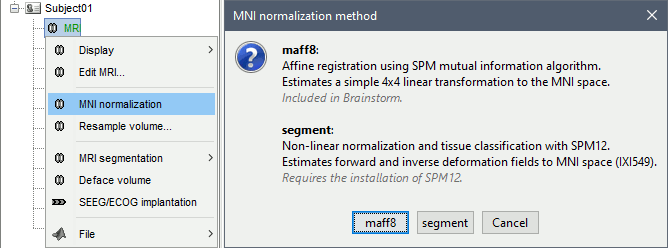
MNI: Linear
A [4x4] affine transformation is computed and saved in the MRI NCS structure:
R: [3x3] rotation matrix from the MRI coordinates to the MNI coordinates.
T: [3x1] translation matrix from the MRI coordinates MNI coordinates.
The function mri_normalize_maff.m uses code from SPM12 (spm_maff8 ©J Ashburner), described in the following article: Ashburner J, Friston KJ, Unified segmentation, NeuroImage 2005
- This transformation is fast to compute, fast to apply to 3D coordinates, and very light in terms of storage. It is appropriate for computing a deformation of the bounding box of the brain and adapted for quickly aligning brains in the same space. However, it cannot represent the differences in the cortical folding of the individual brains.
MNI: Non-linear
- Description
- Significant increase in file size: ...
Templates:
As the reference anatomy, we use the ICBM125 2009c Nonlinear Asymmetric, as described in the tutorial Using the anatomy templates.
MNI parcellations:
...
Talairach coordinates
> This is not much used in Brainstorm anymore.
If we cannot compute the MNI normalization as presented in the previous section, we use an approximation to the Talaraich coordinate system. It relies on two points, the posterior and anterior commissure, and the midsagittal plane. The third point needed here, the interhemispheric point, is used to define this plane. You can read about the differences between these two systems on that page:
Anterior commissure (AC)
Description of the anterior commissure at this Wikipedia page.
Technique to localize it:
Use the axial orientation.
Start from a slice just below the corpus callosum and move around it (slightly up or down)
You are looking for a small fiber tract that connects the two hemispheres
You should find two spots corresponding to this description. The more frontal one is the anterior commissure, the other one is the posterior commissure
Once you have localized it: if it is visible on more than one slice, use the upper one (the one closest to the top of the head).
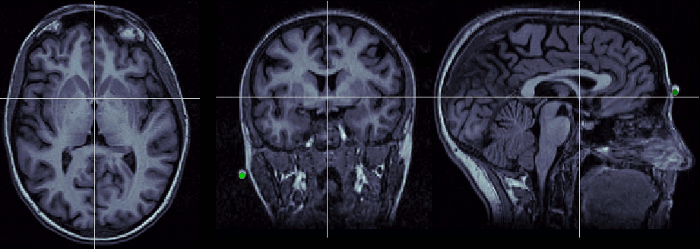
Posterior commissure (PC)
Description of the posterior commissure at this Wikipedia page.
Technique to localize it:
Use the axial orientation
It is a fiber tract similar to the anterior commissure, but a few centimeters more posterior.
If it is visible on more than one slice, pick the lowest one.
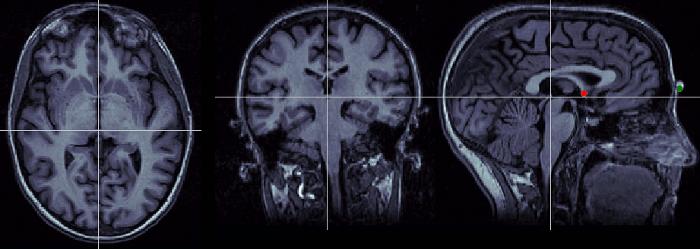
Interhemispheric point (IH)
Pick any point in the interhemispheric space, somewhere in the top of the head. Do not use a point too close from the commissures.
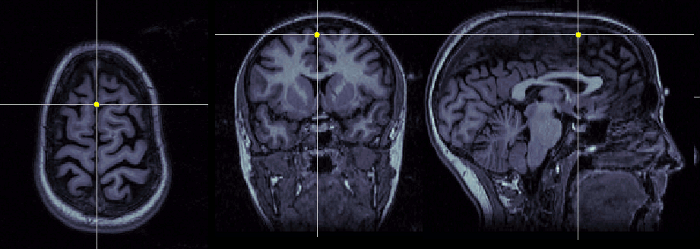
Neuromag coordinates
This coordinates system is not used in Brainstorm, and described here only FYI. All the information contained in Neuromag .FIF files are in this CS, and converted to Brainstorm SCS at importation.
It is defined in the following way:
Based on: Nasion, left pre-auricular point (LPA), and right pre-auricular point (RPA).
Origin: Intersection of the line L through LPA and RPA and a plane orthogonal to L and passing through the nasion.
Axis X: From the origin towards the RPA point (exactly through)
Axis Y: From the origin towards the nasion (exactly through)
Axiz Z: From the origin towards the top of the head
Converting between coordinate systems
The conversions between coordinate systems is handled with one single function cs_convert:
sMri: MRI structure from the database: right-click on the MRI file > File > Export to Matlab > sMri
src/dest: Source and destination coordinates systems: {'voxel', 'mri', 'scs', 'mni', 'world'}
P: List of points [Npoints x 3]
All the the coordinates have to be in meters (not millimeters).
Examples:
Brainstorm .pos files
The .pos files generated with the Brainstorm Digitizer contain both the positions of the anatomical landmarks (nasion, left ear, right ear) and the position of the head localization coils (HPI).
Having the two sets of points allows us to convert automatically from the native CTF coordinates (based on the coils) to the recommended landmarks in Brainstorm (based on the anatomical landmarks). When a Brainstorm .pos file is present in the CTF .ds folder, it is loaded automatically and used to convert the positions of the EEG and MEG sensors to the anatomical reference. This is done automatically without any message or user confirmation. In this case, you should mark the anatomical landmarks (real nasion and tragus/helix junctions) in the MRI Viewer when importing the anatomy. This is what is described in the introduction tutorials.
Otherwise, if you are importing CTF recordings without a Brainstorm .pos file in the .ds folders, or if you are importing the .pos files after linking the recordings to the database, you should typically select the positions of the CTF HPI coils in the MRI viewer.
The syntax of these .pos files is the following, one line per digitized point:
In the .pos files, the anatomical landmarks are labelled Nasion/LPA/RPA, and the CTF HPI coils are labelled HPI-N/HPI-L/HPI-R (for nasion coil, left coil, right coil). Note that in the CTF software, the HPI coils are labelled NAS/LPA/RPA, which can lead to some confusion.
We usually take multiple measures of each reference point and average them when we load the file. This helps improving the accuracy of the registration.
Additional documentation
Tutorial: Channel file / MRI registration
Forum: Bad MEG-MRI registration
Forum: Coregistration validation
Forum: Import the position of SEEG/ECOG contacts: Post #2206, Post #1958, Post #2357
